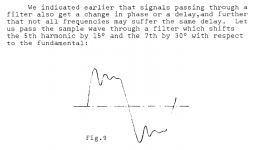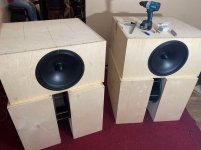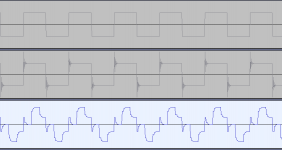Black = Envelope delay is the rate of change of the phase versus frequency curve
Round = Group delay is the time delay of the amplitude envelopes
Tire = Group Delay
Yes tires are black and round
This is the kind of childish fuzzy logic that allows conspiracy theories to appear legitimate to so many. This is not in any way saying the same thing it is conflating two separate words together and saying anytime those two words appear together they are the same. Liquorice Allsorts can be round and black but they make poor tyres.
This is the comparison of words from two sources describing the same thing
"Envelope delay is the rate of change of the phase versus frequency curve."
Group delay is the negative derivative in milliseconds of the phase response. It is a measure of the rate of change of phase with respect to frequency
"The terms envelope delay and group delay are generally used interchangeably"
From the CATV reference there is an input wave
and then the same input when passed through a filter with group delay, the amplitude envelope changed, the waveform looks different.
Attachments
Hi all, maybe some will find a related experiment i've been trying interesting.
The often ridiculous group delay discussion got me remembering some of the wavelet / tone burst experiments i tried earlier this year. (Inspiration to try wavelets came from Signal Aligning Using Wavelets)
The purpose then was to find consistently accurate time-of-flight (ToF) measurements for low frequency drivers. Anybody who has tried to nail down subwoofer ToF's knows the need i'm talking about......
The wavelets, typically 5 cycles of a single freq sine wave, are a signal designed to get both good time and frequency info...albeit as a compromise to both...to get both.
I noticed the wavelets would frequency modulate when passed though a high or low pass filter set to the wavelet freq. If thru a low pass, the wavelets period would increase, and vice versa for thru a high pass. Which made easy sense.
The amplitude envelopes didn't really change all that much....
Anyway, all the going on about transient amplitude modulation from group delay got me to revisit the tone burst idea.
I know full well that phase change wrt frequency is the only thing that really matters, so i thought i'd look at a burst under different degrees of phase change.
Ok enough windspouting...
Here's the burst. A one cycle 100Hz sine wave.
I chose one cycle to make the burst even more transient than a wavelet.
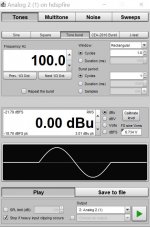
Experiment was to run the burst thru both sides of a xover, and then sum the two sides back together. Knowing that different order xovers would give different degrees of phase change wrt freq.
(I could have used a varying number of all-pass filters for the rotations, but i'm used to working with xovers.)
Here's an example of the two sides that get summed back together electrically and measured with REW's scope.
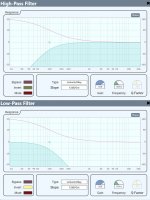
OK, the first scope capture is the burst thru a BW 6dB/oct xover.
That we know has zero phase rotation. Trace looks perfect.
Please note the scope time cursors (vertical) are set to the period of the sine burst, 100Hz.
The cursors will not move as xover order / phase rotation is increased, to help show what phase change wrt freq does to the burst.
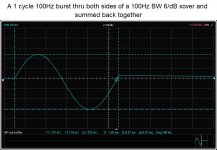
Next a 12dB/oct LR
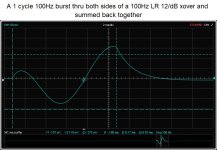
24dB/oct LR
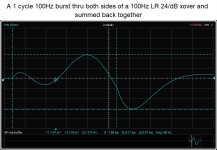
48dB/oct LR
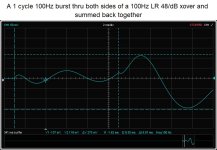
And of course, my ever ongoing plug for complementary linear phase xovers with zero phase rotation at any order desired..
Here's a 96 dB/oct lin phase LR
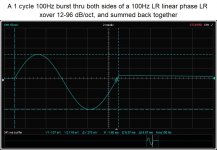
I've looked at impulse responses of xovers aplenty ...many of us have...but the burst is new to me. All due to awesome software like REW and AARTA.
Btw, the REW scope is super! So is the signal generator, and the ability t do these type experiments. All that's needed is a good flexible dsp to play with.
The often ridiculous group delay discussion got me remembering some of the wavelet / tone burst experiments i tried earlier this year. (Inspiration to try wavelets came from Signal Aligning Using Wavelets)
The purpose then was to find consistently accurate time-of-flight (ToF) measurements for low frequency drivers. Anybody who has tried to nail down subwoofer ToF's knows the need i'm talking about......
The wavelets, typically 5 cycles of a single freq sine wave, are a signal designed to get both good time and frequency info...albeit as a compromise to both...to get both.
I noticed the wavelets would frequency modulate when passed though a high or low pass filter set to the wavelet freq. If thru a low pass, the wavelets period would increase, and vice versa for thru a high pass. Which made easy sense.
The amplitude envelopes didn't really change all that much....
Anyway, all the going on about transient amplitude modulation from group delay got me to revisit the tone burst idea.
I know full well that phase change wrt frequency is the only thing that really matters, so i thought i'd look at a burst under different degrees of phase change.
Ok enough windspouting...
Here's the burst. A one cycle 100Hz sine wave.
I chose one cycle to make the burst even more transient than a wavelet.

Experiment was to run the burst thru both sides of a xover, and then sum the two sides back together. Knowing that different order xovers would give different degrees of phase change wrt freq.
(I could have used a varying number of all-pass filters for the rotations, but i'm used to working with xovers.)
Here's an example of the two sides that get summed back together electrically and measured with REW's scope.

OK, the first scope capture is the burst thru a BW 6dB/oct xover.
That we know has zero phase rotation. Trace looks perfect.
Please note the scope time cursors (vertical) are set to the period of the sine burst, 100Hz.
The cursors will not move as xover order / phase rotation is increased, to help show what phase change wrt freq does to the burst.

Next a 12dB/oct LR

24dB/oct LR

48dB/oct LR

And of course, my ever ongoing plug for complementary linear phase xovers with zero phase rotation at any order desired..
Here's a 96 dB/oct lin phase LR

I've looked at impulse responses of xovers aplenty ...many of us have...but the burst is new to me. All due to awesome software like REW and AARTA.
Btw, the REW scope is super! So is the signal generator, and the ability t do these type experiments. All that's needed is a good flexible dsp to play with.
Last edited:
Why did you actually start to focus on group delay in particular, camplo?
I blame reports like the one below (quite widespread in the community, I'm afraid), that handle the GD as something special. It really didn't help in better understanding of the matter, especially to those not educated in signals and systems.
https://pearl-hifi.com/06_Lit_Archi...eCleach_Jean-Michel/Horn_Shootout_ETF2010.pdf
Your reputation precedes you lol, Personally I don't mind you 🙂
Actually I think We got off on this tangent based on an oversimplification by you! "GD is just the FR" or something of those lines lol
Why did you actually start to focus on group delay in particular, camplo?
I blame reports like the one below (quite widespread in the community, I'm afraid), that handle the GD as something special. It really didn't help in better understanding of the matter, especially to those not educated in signals and systems.
https://pearl-hifi.com/06_Lit_Archi...eCleach_Jean-Michel/Horn_Shootout_ETF2010.pdf
It's just one of these almost buzz words, that seem to have a cycle, almost like a season.
Sometimes it comes back, people exchange many many words about it, mostly all theoretical, reinvent the wheel again.
And than it goes away again, since in the end people realize that practical tests need to be done, (which to much work and scary!!!) and all other variables are more important anyway.
Ready to be awaken again and the whole thing repeats itself.
Just grab a bag of popcorn and get yourself a drink 😉😀
This is the kind of childish fuzzy logic that allows conspiracy theories to appear legitimate to so many. This is not in any way saying the same thing it is conflating two separate words together and saying anytime those two words appear together they are the same. Liquorice Allsorts can be round and black but they make poor tyres.
This is the comparison of words from two sources describing the same thing
"Envelope delay is the rate of change of the phase versus frequency curve."
"The terms envelope delay and group delay are generally used interchangeably"
From the CATV reference there is an input wave
and then the same input when passed through a filter with group delay, the amplitude envelope changed, the waveform looks different.
Thats not my logic, thats your logic lol, I just said it back to you, using different words, so you could see what you sound like to me. And yes your type of thinking leads to confusion. Because the aspect of amplitude distortion is as important as the distortion of Frequency of Phase.
"The terms envelope delay and group delay are generally used interchangeably" - What is your point, it is apparent by now that I am focusing on the Amplitude.
If you have this answer, this could probably end our disagreement, How does shifting phase/frequency shift Amplitude? I think possibly tmuikku beat you to it.
Camplo, yes the amplitude envelope is affected why not? You can visualize it by having low and high frequency waves (two sine tones is the simplest) playing same time and record it to the DAW and look the waveform. If you then delay the lower tone the envelope changes (shifts in time) because the higher frequencies seem to ride on the lower tone, the lower tone modulates the highs.
This would relate back to what Mabat said regarding a tone burst not being a sole single frequency.
If you can't explain it simply, you don't understand it well enough.
Not always true. Some things defy a simple explanation. But it seems to me that you now have a sufficient understanding of GD, even if you do prefer a terminology that differs from most of us. Time to move on.
Thank you David and apologies to all, back to the drawing board for me, a learning curve.It's equivalent to a time delay of 25 milliseconds, which is not the same as group delay.
The group delay will depend on the instantaneous rate of change of phase at 10 Hz, not just on its absolute 90 degree value.
Have you read Post #8456?
This is where I left off...soon after this, I ran into the issue with the measurements of the AEtd15m being wrong and until I get that sorted I am sort of at a stand still....The 150hz horns probably will not be here for another 4 weeks...I have another 5-6 weeks of work left so the timing is good. I work crazy hours in the summer and then have 6 months off. Hard to do anything but verbal discussions online. Tis the life of a road construction worker.
Maybe its time to start developing a waveguide for the Axi2050.
Any suggestions? Seems like 15" diameter is the place to start....
Attachments
This is my best effort at a simple demonstration. I have attached three audio samples zipped up. There is a square wave at 440Hz. Then two different allpass filters are applied to the square wave. The first one causes clipping at the front of the step, the second one mangles it completely.If you can't explain it simply, you don't understand it well enough.
But the sound is really quite similar. The clipped one sounds a bit distorted, but they don't sound anywhere as different as their respective amplitude envelopes show. All that was changed was the phase and associated group delay and this was the result.
+1Time to move on.
Attachments
Camplo,
as you have free time you could take a look at this ( and the link Charles gave too, maybe there is automatic subtitle translation within YT?) as this document might be of interest too:
https://www.diyaudio.com/forums/multi-way/377671-soundstage-11.html#post6810060
But i agree with Earl and Fluid, time to move on ( until the next round which will happen circa page 1500 of this thread when you'll have digested all this and created a glossary and translation of the term you use to the one the rest of the world use.
 😀 ).
😀 ).
as you have free time you could take a look at this ( and the link Charles gave too, maybe there is automatic subtitle translation within YT?) as this document might be of interest too:
https://www.diyaudio.com/forums/multi-way/377671-soundstage-11.html#post6810060
But i agree with Earl and Fluid, time to move on ( until the next round which will happen circa page 1500 of this thread when you'll have digested all this and created a glossary and translation of the term you use to the one the rest of the world use.

 😀 ).
😀 ).Waveguide compared to more Contemporary and Traditional Horn.
From what I've gathered in readings, A horn produces a better IR....Is this true? If it were true, I would think that its due to the lesser amount of reflections in the room but that would not make perfect sense if this trait is still the case with outdoor measurements or anechoic. So, I wonder what is the case?
I imagine that this "better" IR via horn is had at the sweet spot. Where as maybe the Waveguide has wider performance...I don't know if people look at the IR of an off axis measurement and consider it...makes sense to me.
Horn is trading wider IR performance for higher sweet spot IR
Waveguide is trading higher sweet spot IR for wider IR performance
is the conclusion that I made a while ago. Is it true?
From what I've gathered in readings, A horn produces a better IR....Is this true? If it were true, I would think that its due to the lesser amount of reflections in the room but that would not make perfect sense if this trait is still the case with outdoor measurements or anechoic. So, I wonder what is the case?
I imagine that this "better" IR via horn is had at the sweet spot. Where as maybe the Waveguide has wider performance...I don't know if people look at the IR of an off axis measurement and consider it...makes sense to me.
Horn is trading wider IR performance for higher sweet spot IR
Waveguide is trading higher sweet spot IR for wider IR performance
is the conclusion that I made a while ago. Is it true?
When equalized to the same frequency response, all the devices will have the same impulse response as well.
- It's the same as with group delay, it's still the same thing, only seen from different perspective. But it seems you deliberately decided to ignore this fact.
- It's the same as with group delay, it's still the same thing, only seen from different perspective. But it seems you deliberately decided to ignore this fact.
Last edited:
In a room, the polar pattern is also taken into account. A resulting IR can be a combination of different levels of direct vs indirect energy, thus creating different IR even though FR is similar.... you forgot about this it seems.
I would theorize that the approach that causes the least amount of reflections creates the best IR in a room, looking at dead on axis....actually my first description above is likely closer to the truth than your inaccurate oversimplification which could only be possibly true in an anechoic environment
I would theorize that the approach that causes the least amount of reflections creates the best IR in a room, looking at dead on axis....actually my first description above is likely closer to the truth than your inaccurate oversimplification which could only be possibly true in an anechoic environment
Last edited:
There are two ways to consider the impulse response, the driver and guide alone in an anechoic measurement which is what mabat was describing and the second case where you consider the response of the system in room.
This becomes more about coverage angles, other items nearby, room treatments etc. You can have a narrow waveguide and a wide horn so the distinction between them in this situation is arbitrary.
Narrowing the coverage in an ordinary room will most likely result in a cleaner impulse response. Whether that is preferred is a different question as the giant headphone presentation is not to everyone's liking.
This becomes more about coverage angles, other items nearby, room treatments etc. You can have a narrow waveguide and a wide horn so the distinction between them in this situation is arbitrary.
Narrowing the coverage in an ordinary room will most likely result in a cleaner impulse response. Whether that is preferred is a different question as the giant headphone presentation is not to everyone's liking.
- Home
- Loudspeakers
- Multi-Way
- Is it possible to cover the whole spectrum, high SPL, low distortion with a 2-way?

